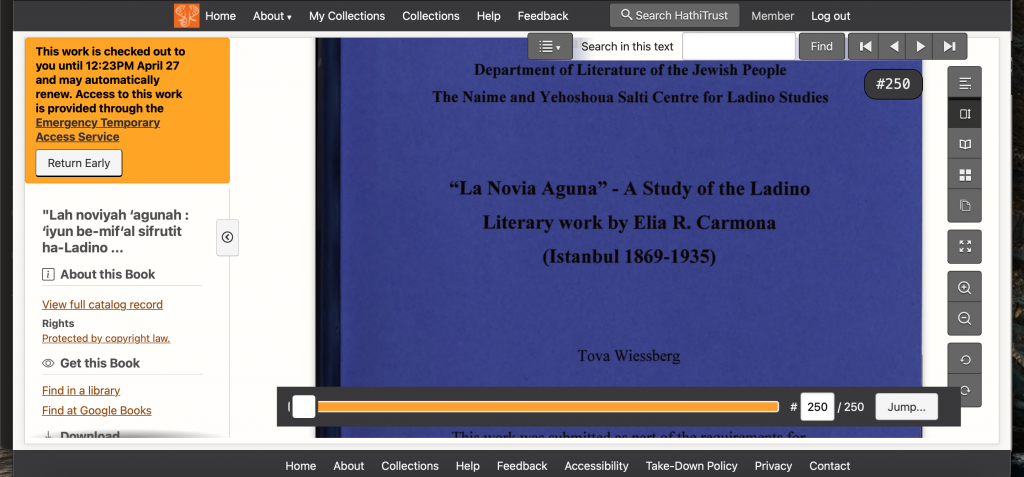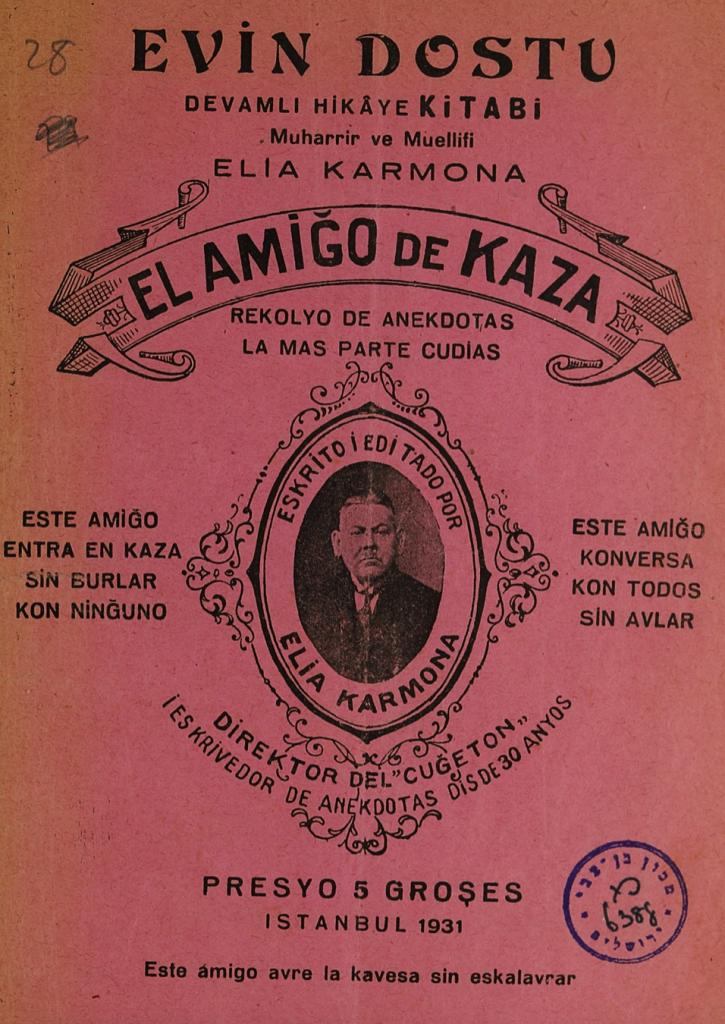Written by Marina Mayorski (Graduate Student Research Assistant and PhD Candidate, University of Michigan)
As a scholar of Judaic Studies, I study literary texts written in three different Jewish languages – Hebrew, Ladino, and Yiddish. Searching academic repositories for material written in non-Roman writing systems can be an excruciating task. Consider the following title, taken from the HathiTrust repository:
“Lah noviyah ʻagunah : ʻiyun be-mifʻal sifrutit ha-Ladino shel Eliyah R. Ḳarmonah (Istanbul 1869-1935) Ṭovah Ṿaisberg “לה נוב’ייה עגונה” עיון במפעל ספרות הלאדינו של אליה ר’ קארמונה

This is a research paper written by Tova Weissberg in 2006 that deals with modern Ladino literature. The paper itself is written in modern Hebrew, with the object of its investigation (primary sources) being Ladino texts written in the Hebrew alphabet using Rashi script.
How might we find this title in the HathiTrust repository? The combination of two Jewish languages that use the Hebrew script (each in a different way), both transliterated to Roman script, raises a number of difficulties.
But first, how did we get here?
Jewish communities have historically spoken and written distinctly from their non-Jewish neighbors, adopting and adapting various languages spoken in the areas they inhabited, while restricting the use of Hebrew primarily to liturgical contexts. These differences can be minor, such as supplementing the non-Jewish language with some Hebrew or Aramaic words, but they could also be significant, constituting an entirely different linguistic system, unintelligible to speakers of the non-Jewish language. Within this spectrum, defined by scholars as to the “continuum of Jewish distinctiveness,” most Jewish communities throughout history were located somewhere in the middle. This distinctive Jewish linguistic repertoire has often included an orthographic system based on Hebrew / Aramaic, a tendency that was especially common in languages that were first written in medieval times, such as Ladino / Judeo-Spanish, Yiddish, and Judeo-Persian. However, contemporary Jewish languages are usually written in the same orthographic system that is used by their territorial non-Jewish languages. The reasons for this shift are rooted in the socio-political changes occurring during the modern era, leading Jews to attain high levels of literacy in national languages. But the traditional Hebrew / Aramaic alphabet is still present in modern and even contemporary Jewish languages, and, of course, in modern Hebrew.
There are, however, significant differences between the ways that the Hebrew alphabet is used in Jewish languages such as Ladino and Yiddish, and the way it is used in modern Hebrew. Some of these differences are rooted in the phonetic and orthographic character of the non-Jewish linguistic system that the Hebrew alphabet functions in, requiring additional features and divergent use. The phonetic characteristics of the non-Jewish languages and orthographic possibilities contained in the Hebrew script can engender gaps and challenges in both reading and transliteration (into Roman script, for example).
These dynamics are illustrated in Ladino (sometimes referred to as Judeo-Spanish, Judeo Espanyol, Spanyolit, or Judezmo), which traditionally used the Hebrew alphabet until a gradual transition to Roman script (and to Cyrillics in Bulgaria) in the twentieth century. Ladino is the Ibero-Romance language used by Jews originating from the Iberian Peninsula. It was carried with the Jews who were expelled from Spain and Portugal in the late fifteenth and early sixteenth centuries, to the lands they went on to inhabit, namely the Ottoman Empire, North Africa, and the Americas. The exiles, who became known as Sephardim (Sepharad means “Spain” in Hebrew), continued to use their fifteenth-century Spanish, which went on to absorb various elements of the languages spoken in their new homes, such as Ottoman Turkish, Greek, Arabic, Italian, French, and Slavic languages. Scholars are conflicted about the question of whether or not there was a specific Jewish language in Spain before the expulsion. But the alphabet traditionally used for its writing was Hebrew, with Eastern Sephardim (those who settled in the Ottoman Empire, a portion that constituted the majority of exiles) using a typeface called Rashi script for printed materials.
In the example below, we can see the difference between the script used for Ladino (top of the page), and the script used for modern Hebrew (middle of the page), both using the Hebrew alphabet:

While Jews in Salonika continued to use the Rashi script until the community was destroyed in World War II, the Jews who remained in Turkey were forced to adopt the Roman script, according to a 1928 decree issued by Mustafa Kemal Atatürk in 1928, which replaced all other scripts in the new republic. Such transitions created difficulties in transliteration, which persist today in the few existing Ladino publications, with three different transliteration systems into Roman script. It is also important to note that the Ladino language has never been standardized (unlike Yiddish, for example), leading to different spellings of the same words in different locations, and sometimes even within the very same work, by the same author.
These dynamics are illustrated in the title of the paper examined here, which includes the name of the Ladino novel that is at the center of Weissberg’s study, “La Novya Aguna” (לה נוב׳ייה עגונה) which literally means “the chained bride.” The remainder of the title reads, in Hebrew, “a study of the Ladino literature of Elia R. Karmona (Istanbul 1989-1935).” The two words comprising the novel’s title provide an example of the encounter of the two languages, with their divergent use of the same alphabet, as well as a testament to Ladino’s hybrid nature, combining “Novya” (a Spanish word, written in contemporary Spanish as “novia,” which means bride, fiancée, or girlfriend), and “Agunah” (a Hebrew word, first appearing in the Bible). Words of Hebrew and Aramaic origin were usually preserved in their original spelling and not in phonetic spelling (but such words were often spelled incorrectly, due to authors’ poor command of Hebrew), whereas words from other origins were written phonetically.

So, how can we find this title in the HathiTrust repository? To understand the challenges, we need to unpack the coupling of the two Jewish languages that use the Hebrew script, and the ways that they are transliterated to Roman script. We should remember that each language has its own distinct transliteration system, but both correspond to the same basic writing system, albeit in different ways. Here’s the title again, as it appears in the HathiTrust repository:
“Lah noviyah ʻagunah : ʻiyun be-mifʻal sifrutit ha-Ladino shel Eliyah R. Ḳarmonah (Istanbul 1869-1935) Ṭovah Ṿaisberg “לה נוב’ייה עגונה” עיון במפעל ספרות הלאדינו של אליה ר’ קארמונה
We can see that all three words in the title of the novel in question are spelled with the letter H in the end, a letter often (but not always) used in the transliteration of the Hebrew ה when it appears in the end of the words. In a transliterated version of the novel published online by scholar Olga Borovaya, these words appear without the letter H, and it would be difficult for someone searching for the title to know whether or not to include H at the ends of these words, since it is silent and not pronounced. The English title that appears within the paper itself, for example, does not include H in these places:

The word “Novia,” as we can see, is transliterated differently in the HathiTrust title and in the English title within the paper. Neither of them follows the most popular Ladino transliteration system, adopted by the Library of Congress, according to which it would be spelled “Novya.”
The transliteration used within the body of the paper also uses a different spelling for the name of the Ladino author that this research investigates: “Elia R. Carmona,” compared to “Eliya R. Karmonah” in the HathiTrust repository. Traditionally, all K sounds in Ladino have been transliterated using the letter K and not C (in contrast to modern Spanish). The Ladino author himself wrote his name in Roman script in works published in the 1930s (after Turkey’s language reform), spelling it “Elia Karmona,” as we can see in the following example:

It is also noteworthy that the HathiTrust title transliterated the Hebrew subtitle of the work incorrectly. The Hebrew subtitle is “עיון במפעל ספרות הלאדינו של אליה ר’ קארמונה” (meaning: a study of the Ladino literature of Elia R. Karmona). The highlighted word means “literature” and should be transliterated as “sifrut” but the transliteration used here is: ‘״iyun be-mifʻal sifrutit ha-Ladino” (“Sifrutit” means “literary.” In Hebrew, this sentence is grammatically incorrect).
We can see how this single item illustrates the complexities born from the use of multiple languages in one text, as well the challenges of searching repositories such as HathiTrust for materials written in non-Roman scripts. These issues will be explored in the Mellon-Sawyer seminar, Building Translation Networks in the Midwest with HathiTrust, led by Christi Merrill, forthcoming this fall.




